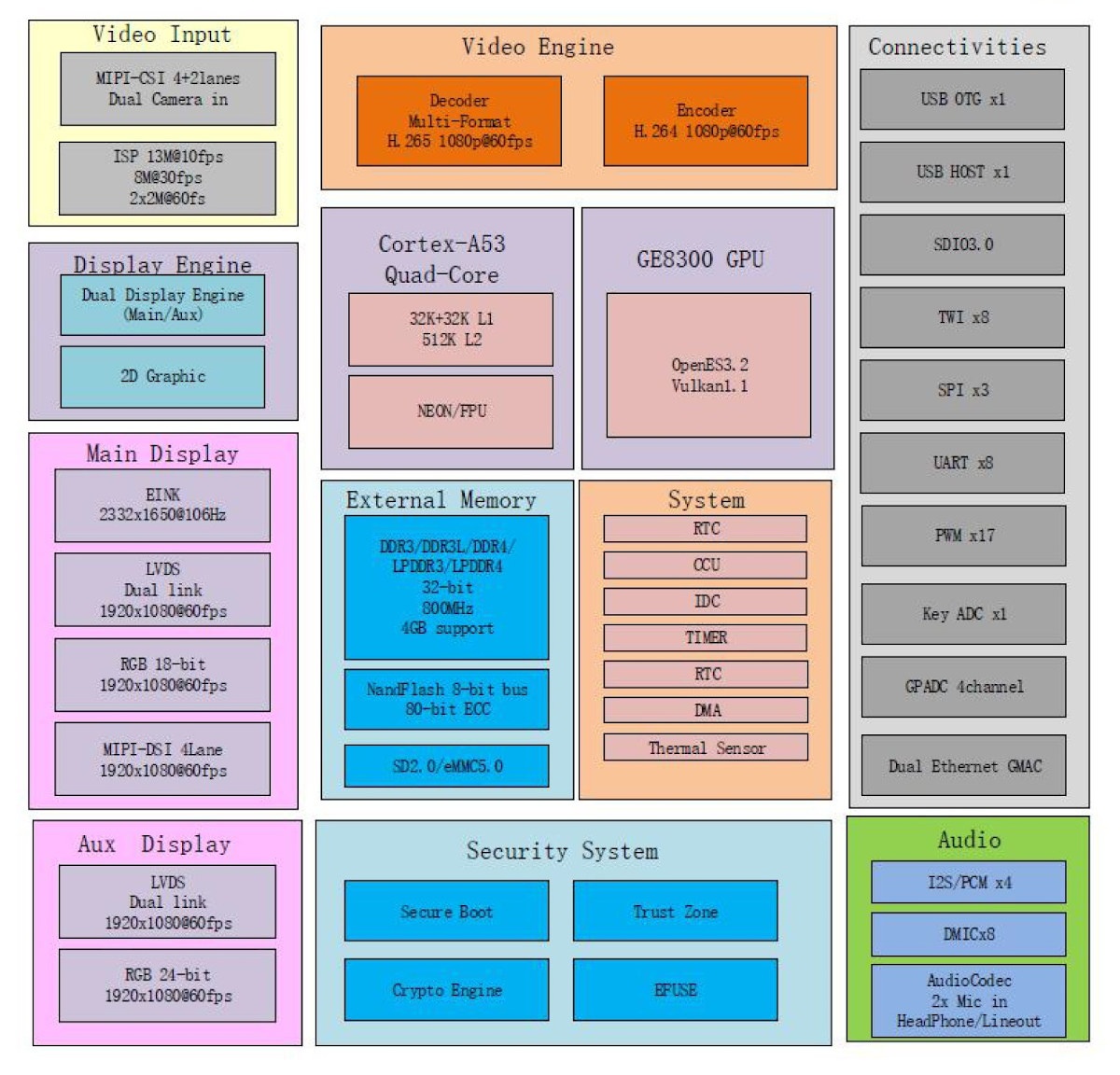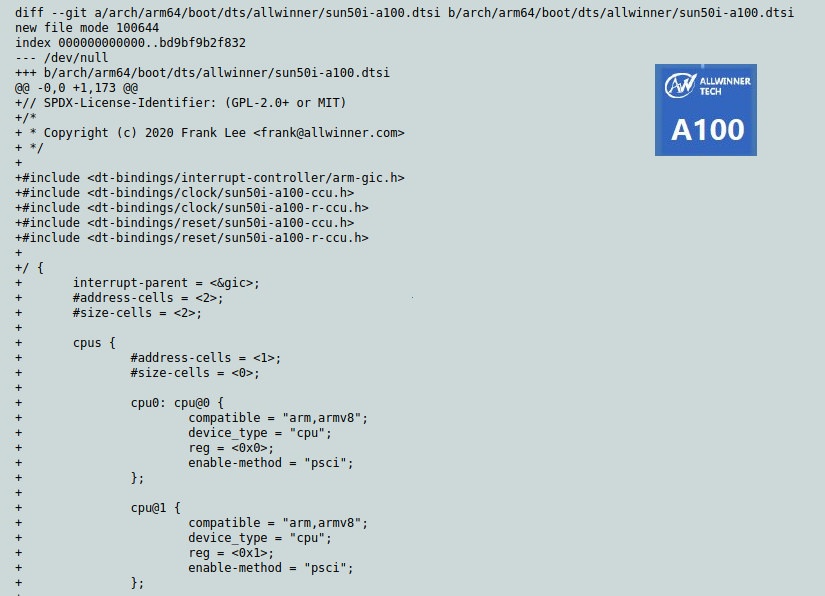You may also have already used boards based on Allwinner processors with mainline Linux support. But so far you had to thank linux-sunxi community for all the mainlining work they do, and AFAIK Allwinner was not involved.
But today, I noticed Allwinner A100 initial support was submitted by Frank Lee with an AllwinnerTech dot com email address, and although the company was involved in some other patchsets, AFAIK it might be the first time they work on mainlining one of their processors.
Allwinner A100 is a mid-range tablet processor with a quad-core Cortex-A53 processor, an Imagination PowerVR GE8300 GPU, 4K video decode and 1080p encode that looks to be a replacement for/upgrade to the popular Allwinner A64.
The patchset itself brings initial support for the four Cortex-A53 cores, clock and pinctrl, as well as the Device Tree file. There’s also mentioned of Allwinner Perf1 Allwinner A100 SBC with 1GB DDR3, AXP803 PMIC, two USB 2.0 ports, onboard NAND flash, MicroSD slot, and on-board eMMC module. It’s unclear whether Perf1 will stay an internal board for development, or will eventually become available to the broader developer community. In any case, it’s very good news that Allwinner may become more involved in mainline Linux.

Via Phoronix and thanks to Jon for the tip.

Jean-Luc started CNX Software in 2010 as a part-time endeavor, before quitting his job as a software engineering manager, and starting to write daily news, and reviews full time later in 2011.
Support CNX Software! Donate via cryptocurrencies, become a Patron on Patreon, or purchase goods on Amazon or Aliexpress





PowerVR…
Let’s see maybe it’s a great start.
>Let’s see maybe it’s a great start.
TBH this is very basic stuff. Allwinner would be crazy at this point to write replacements for all of the stuff that is in the kernel instead of just wiring up what is already there. I doubt they’ll come through with drivers for stuff that is hard to reverse engineer and really they are just doing themselves a favour with trying to mainline this as it’ll mean the crap they bolt on is less likely to have merge conflicts when they need to bump kernel versions.
Allwinner and bumping kernel versions 😉
Would be great if they finally would have understood the benefits of mainline!
I think they probably already know the benefits of mainlining. Especially the poor guys that keep having to drag the same set of shitty patches between kernel versions.
For the fabless ARM houses their software is everything so trying to convince people that look a graphs all day that you want to “give away our software” isn’t going to be easy. Much easier to join Linaro to look like your might stop GPL infringing and leave it at that.
If their “software is everything” they sure are doing a rotten job of it. I can name over a dozen SOCs we have evaluated and then abandoned due to non-functional software. I won’t buy and ship your SOCs if I can’t get the software secure and stable in my product.
Get a clue and open source your code and put it into mainline. That’s how you get your software to work in the long run. What does it hurt to open source this SOC driver code? It’s not like the code for your design of an h.264 encoder is going to run on another vendor’s design. Opening your code is going the HELP you, not hurt you. Mainline is actually less work than staying out of tree. If open code is so evil, why doesn’t the x86 fail?
I hate this continuous churn of a new CPU every 18 months. And it comes with a new set of buggy software with a new set of security holes. And then by the time I get it fixed up they drop the CPU. Putting everything into mainline would make these transitions between SOCs so much easier. 90% of the time I don’t even care about the features in the new version of the chip, I ‘m simply transitioning because they EOL’d the previous version.
Here’s an example — the Allwinner V3./S3/R11. It is actually a very good chip and it would probably sell for a another decade if Allwinner would simply support it. It is very well matched to today’s IOT devices. But Allwinner ignores it and key pieces of the kernel are closed source. So if you want the camera to work you are stuck on kernel 3.10. And that kind of sucks for IOT since 3.10 is from before Bluetooth Low Energy existed. So no BLE on the V3/S3. If all of the V3 code were mainlined we could keep the device working on mainline kernels with minimal effort and it would have working BLE.
After working extensively with software engineers in China, figured out that this is not easy for them. So I did the next logical thing, go with people outside of China for software 😀
Interesting insight
just which vendor is better?
The best ARM kernel support is probably the NXP iMX line.
Not exactly consumer grade. 🙂
>just which vendor is better?
Dunno. Vendor code is generally garbage. I would pick a vendor knowing their stuff is garbage but looking for other plus points like are they maintaining their horrible patch set on a recent LTS kernel, is it on github for the world to see instead of a tarball you can only get under NDA, is there enough hardware documentation to fix their code if it doesn’t work,.. If you want to use video encoders/decoders, GPUs etc you’re basically between a rock and a hard place.
Like with uCs where the quality of the datasheet tells the cream apart from the crap…
Atmel and Motorola were a league of their own at the time.
But who has the resources to write all drivers from the datasheet, when the SOC is eol as soon as the product reaches the market.
The problem is that they aren’t even trying to put their code into mainline. The people that maintain mainline will do whatever it takes to get the code they submit working.
Here’s an example. Allwinner joined Linaro. As part of joining they can send engineers to Linaro to be trained on software practices and how to develop for the kernel. Did Allwinner ever send an engineer? No. All they did was send a couple of marketing people. After a year or two they dropped out of Linaro.
wow, the really leave linaro ?
They have since rejoined. But they do nothing with their membership.
>If their “software is everything” they sure are doing a rotten job of it.
Sure but pretty much all software in this area is horrible even from the big western vendors.
Open source software is a hardware vendor’s best friend. It’s amazing how long it takes some of them to catch on.
Note the PowerVR graphics. Not very open source there. Quite the opposite.
Are people here with connection into the chinese industry? Would be nice to just push them to do it more. I think they could sell more chips, if the software support is better. I have a couple of SoCs here. The SoCs are not that bad. It’s mainly the software support which sucks.
Interesting to see whether it’ll follow up with the peripherals like display, audio, storage, ports …
Curious, what is the motivtion, behind mainlining A-series tablet SoC, rather than an “industrial” one R or T series
So let’s see how it goes. Also still no SDK/BSP datasheet/user manual for the H616/H313, although tv boxes are found around.